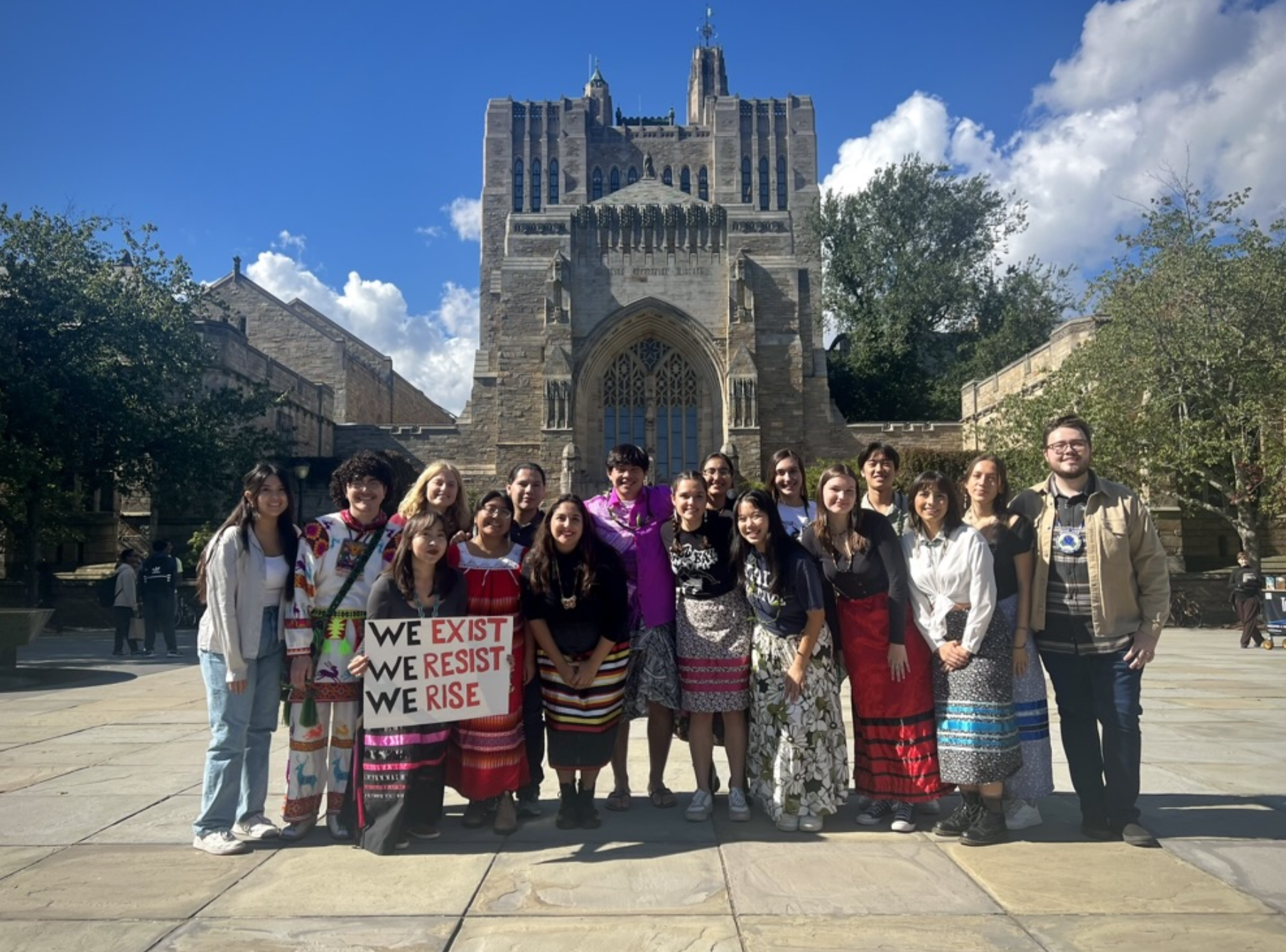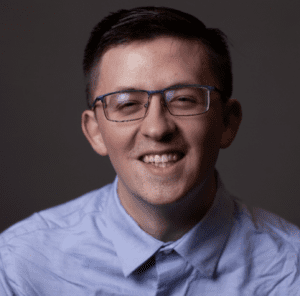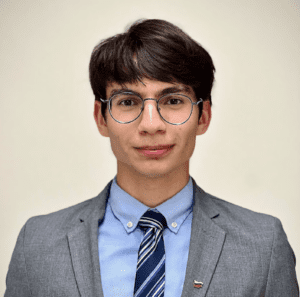PROFILES: Indigenous excellence in STEM at Yale
[ad_1]
As Indigenous communities across the country hold celebrations for Native American Heritage Month, we note great achievements in the sciences by Native peoples. Whether in the critically acclaimed writings of botanist Robin Wall Kimmerer, or looking to the stars where Nicole Mann became the first Native American woman in space, our people see countless examples of Indigenous Excellence in STEM.
We wish to share Indigenous STEM Excellence on our own campus through the work of our peers. Indigenous Yalies bring their unique perspectives and backgrounds to their work and excel in fields of research, professionalism and community outreach. Through the Yale Chapter of the American Indian Science and Engineering Society, or yAISES, Indigenous scientists at Yale have built a community of support, mentorship and success. yAISES’ over 40 current members have worked earnestly to increase Indigenous representation in STEM at Yale and beyond, an effort which earned them a national Chapter Award at the AISES National Conference this October.
We asked four of our members to share their journeys in STEM — their takeaways, their current work and what comes next. They represent all four years in Yale College, a diverse set of majors, interests and backgrounds, and above all, Indigenous Excellence in STEM.
Major: Earth and Planetary Sciences
Native Affiliation: Tsalagi
Can you share a pivotal moment in your educational journey that led you to pursue a career in STEM?
In sixth grade, I was taking my first ever science class, earth science, and my teacher absolutely hated me. I always made sure my assignments were perfect and I knew all the material, so she couldn’t call me up in front of the class and ridicule me. One day, my teacher called me up to her desk, and she laid out an assignment on ocean currents and accused me of cheating on it, saying that no one had ever gotten all of the questions right in all of her years of teaching. She told me she “just knew” I wasn’t really good at science — probably racism — and I must be cheating. I was never particularly interested in science before this, but in a way, I started being more invested out of spite. At first I was more interested in biological sciences, but ironically, I ended up studying Earth science, the same subject my teacher accused me of cheating in.
How has your Indigeneity influenced your approach to STEM research and study?
As an Indigenous Earth and planetary scientist, I find it of utmost importance to legitimize Ethnogeology as a field of study. Ethnogeology is the study of how Indigenous peoples view and interact with geological features, and how they conceptualize geological concepts such as earthquakes. This has influenced one of my research projects directly — for the past two years, I’ve been using earthquake waves to image the Cascadia Subduction Zone, a region centering on the Juan de Fuca megathrust fault in the Pacific Northwest. Up until the 1980s, no one believed that the fault could produce earthquakes, even though the Indigenous peoples of the region had documented a massive quake and tsunami in their oral history. White scientists found scientific evidence for such an event and acted like they had invented this theory, even though Native people had been saying it for generations. It’s my responsibility as a Native person to uplift the voices of Indigenous peoples that have stewarded the land we study and ensure that other scientists are treating these lands and their people with respect and dignity.
What challenges have you faced as an Indigenous student in the sciences, and how have you overcome them?
It’s difficult to be Native in STEM, especially in Earth and Planetary Science. The majority of fieldwork for planetary science is conducted on Native land and reservations in the Southwest, and we have to fight for that to be recognized and for our colleagues to treat the land and its stewards with respect. In Hawai’i, there is a massive telescope being built on a sacred site in the name of planetary science that academics I respect and look up to have visited. These things make Native scientists feel unwelcome in these spaces. I’m lucky enough to have other Native people in STEM to guide me and support me. Selena Martinez ’22, in particular, was a Cherokee senior in the EPS major when I was a sophomore, and she has been such a light through my college journey. She taught me to advocate for myself and my people in and out of the classroom. Selena also recommended me to be the undergraduate representative on the EPS department IDEA committee, which deals with inclusivity, diversity, equity and anti-discrimination. Without the support of people like Selena, I don’t know what I would do.
What achievements or contributions in your field are you most proud of, and what impact do you hope they will have?
I feel like I haven’t made any big contributions in either seismology or planetary science, which I hope will change soon! However, what comes to mind is my research at the NASA Johnson Space Center & Lunar and Planetary Institute Summer Intern Program from this summer. I researched volcanoes and volcano-tectonic structures on Venus. I quantitatively characterized the topography of real structures on Venus, and then connected the topographic parameters of those structures to those of evolutionary models of edifices on Venus. The models I worked with were mostly written by others, but I made adjustments that helped better fit the models to our current observations of volcano-tectonic features and topography on Venus. These models have the potential to inform the science on future NASA and ESA missions to Venus, particularly concerning the objectives of sounding radar. It would be cool to see anything I or my advisor worked on be used for a NASA mission!
Looking to the future, what are your professional goals, and what is your plan for the future of your STEM career?
I’m taking a gap year after college and moving to Houston, where I did my NASA/LPI internship. I plan on going to graduate school and getting my PhD in planetary science, probably combining the geophysical and geochemical work I’ve done in undergrad to learn more about the interiors of potentially habitable planetary bodies. I don’t know whether I’ll be a professor or a career scientist at NASA, but either way I hope to continue research until they have to pry me away from the lab.
Major: Economics; Statistics and Data Science
Native Affiliation: Gwichyaa Zhee Gwich’in, Athabaskan
Can you share a pivotal moment in your educational journey that led you to pursue a career in STEM?
In high school, I was involved in the Academic Decathlon, an academic competition that really helped hone my appreciation for STEM and learning more broadly. It made learning more fun, and it helped me build a lot of really useful skills that have stayed with me to this day.
How has your Indigeneity influenced your approach to STEM research and study?
I think my Indigeneity has impacted my work though forcing me to consider my future with my family and people in mind. I have a lot of interests and skills, but I feel a strong obligation to make sure my work connects my skills with the needs of my community. Whenever possible, I’ve tried to connect my work at Yale directly to my people back home. For instance, one of the essays I’m most proud of was my final paper in ECON 170: “Health Economics and Public Policy,” where I analyzed the development and history of telemedicine as a means of providing care for Alaska Native people in rural areas.
What challenges have you faced as an Indigenous student in the sciences, and how have you overcome them?
As a first-generation, low-income student, I think the hardest part about navigating STEM as an Indigenous person has been finding and taking advantage of opportunities. At my high school, I never really asked for help, and I didn’t have a ton of support or opportunities. Asking for help and learning to utilize resources was something I had to actively learn. I think one of the ways in which I’ve grown is that I take advantage of resources more, especially through my connections to the NACC and AISES.
What achievements or contributions in your field are you most proud of, and what impact do you hope they will have?
I’m most proud of my work in conjunction with my summer internship with DataHaven. I put a lot of work into drafting a socioeconomic and demographic profile of Indigenous people within Connecticut, and have continued to work towards writing a qualitative white paper addressing data gaps and data sovereignty. Indigenous populations deserve access to public data and are too often ignored or excluded from public data altogether.
Looking to the future, what are your professional goals, and what is your plan for the future of your STEM career?
I see myself working in Alaska. I feel very sure that I will return home. I’d like to do work involving economics or econometrics, but I’m not sure where I will end up being. One possible avenue I could foresee is working for an Alaska Native Regional Corporation, but I will see how things play out.
Major: Computer Science and Psychology
Native affiliation: Native Hawaiian
Can you share a pivotal moment in your educational journey that led you to pursue a career in STEM?
There have been a lot of small moments in my educational journey that ultimately led me to pursue a career in STEM, but I think one that really sticks out to me is the summer after my freshman year at Yale when I had my first experience working in the tech field. I worked on a team with four others to create a new tech innovation, and I’ve never felt so passionate and put so much of my heart into a STEM project before!
How has your Indigeneity influenced your approach to STEM research and study?
For me, it really manifests in seeing how I can create change through STEM to help power Indigenous communities. I love learning about how I can create products that infuse my own passions of technology with my personal upbringing.
What challenges have you faced as an Indigenous student in the sciences, and how have you overcome them?
I think the biggest challenge that I have faced being an Indigenous student in STEM is overcoming my own doubts about pursuing the field. Being an Indigenous woman pursuing a computer science degree — in 2022, in the entire U.S., there were a total of 84 Indigenous women graduating with computer science degrees — I am a part of an incredibly small percentage of the population, which at times can feel daunting and isolating,but I’ve been able to find incredible support and safe spaces from Indigenous women who are already killing it in the tech field!
What achievements or contributions in your field are you most proud of, and what impact do you hope they will have?
My proudest achievement — which was not entirely my own, but a group effort — was winning Chapter of the Year at the AISES National Conference. Seeing all of the hard work that Yale Natives in STEM have been putting in over the past years finally be recognized and applauded was such an incredible moment, and one that I’ll cherish far beyond my time at Yale.
Looking to the future, what are your professional goals, and what is your plan for the future of your STEM career?
My professional goals are to become a product manager and work to create more inclusive and diverse tech products. I also want to work to increase the number of Indigenous women in tech and support others who are considering beginning this journey!
College: Jonathan Edwards
Major: Molecular, Cellular, and Developmental Biology
Native Affiliation: Alaskan Athabaskan
Can you share a pivotal moment in your educational journey that led you to pursue a career in STEM?
Two summers ago, I found myself performing immunomicroscopy for the first time alongside a grad student in my former lab. It didn’t hit me until after we’d left the dark room that we were the first people on the planet to lay eyes on the images I had just analyzed. We’d just delineated a phenomenon with huge implications for future cancer therapies. It was moments like these that led me to pursue a career in STEM; I realized more and more that — uniquely in science — one discovers completely new things about the universe and its systems. You find yourself on the verge of what is known and unknown, and you get to push the boundaries of what is known — and unknown — further and further in your work.
How has your Indigeneity influenced your approach to STEM research and study?
I think the ways in which my Indigeneity has influenced my approach to STEM research and study most is by instilling in me a deep sense of responsibility for posterity. Furthermore, and connected to this point, it has also influenced my commitment to engaging and collaborating with local communities by organizing field trips and discussion groups for local high school students. I also believe my Indigeneity has caused me to embrace fostering creativity, innovation and diversity of thought and perspective in approaching experimental design, ethical considerations and collaboration.
What challenges have you faced as an Indigenous student in the sciences, and how have you overcome them?
By far the biggest challenge I have faced as an Indigenous student in the sciences is finding other students in my year to work with. Especially in biology and chemistry classes, where “teaching” your friends can really help iron out any misunderstandings, this is crucial. The way I have worked to overcome this challenge is, yes, via the regular resources — office hours, peer tutoring, etc. However, I’ve also used these resources as avenues for meeting peers who would be open to forming study groups and things of that nature.
What achievements or contributions in your field are you most proud of, and what impact do you hope they will have?
The week before Thanksgiving break, my mentors and I successfully created a vector with capabilities to self-splice into circular RNA — a very stable type RNA, not susceptible to degradation in ways single or double stranded RNA are, because it does not elicit the antiviral response — from a plasmid we received from our collaborators at Stanford as well as some other pieces. Unfortunately, I am not allowed to go into the details much, but I am very happy about this result and hope it will go on to contribute to various new laboratory methods and therapeutic approaches.
Looking to the future, what are your professional goals, and what is your plan for the future of your STEM career?
In the short-term, I plan to pursue a Fulbright scholarship in Bulgaria, where I aim to delve deeper into the therapeutic applications of circular RNA. Afterward, I aspire to do a Medical Scientist Training Program to enhance my ability to bridge the gap between clinical and basic science research. Beyond this, though, I aspire to pursue an MSTP because those who have completed one of these programs hold a unique possibility to play a broader role in shaping the culture, curriculum of their medical institutions and, ultimately, how the public interfaces with medicine and science.
Madeline Gupta ’25 (Sault Ste. Marie Tribe of Chippewa Indians) is the founder and was co-president of the Yale American Indian Science and Engineering Society. Contact her at madeline.gupta@yale.edu.
Jordan Sahly ’25 (Eastern Shoshone Tribe) was also co-president of yAISES and can be contacted at jordan.sahly@yale.edu .
[ad_2]






